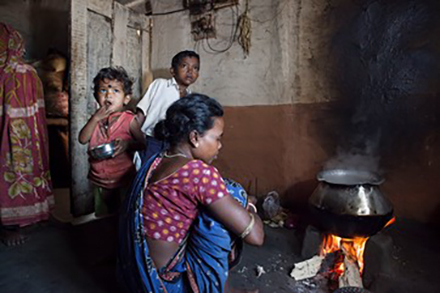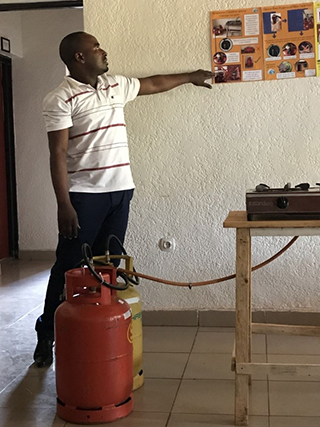By Lauren Sprouse

The Household Air Pollution Intervention Network (HAPIN) trial, an international, multicenter study to assess the health impacts of using cleaner alternatives for cooking fuels, has renewed for a second phase .
Globally, an estimated 2.4 billion people, mostly in low- and middle-income countries (LMICs), cook on open fires and traditional stoves that use biomass, solid fuels such as coal, wood, or agricultural waste. Burning solid fuels generates harmful air pollution that not only contributes to climate change, but is also associated with multiple health conditions, including chronic lung disease, cancer, preterm birth, and childhood stunting.
The HAPIN trial was funded by six NIH institutes, including NIEHS, and the Bill & Melinda Gates Foundation . The first phase of the study, conducted from 2017-2021 in Guatemala, India, Peru, and Rwanda, tested the effects of a liquified petroleum gas (LPG) stove and fuel intervention in settings relying on biomass for cooking. LPG is the most widely available clean fuel in LMICs, making it an appropriate alternative to reduce air pollution exposures from combustion stoves.
"Air pollution causes an estimated 7 million deaths annually, but much of this disease burden lies in low-income settings that are forced to rely on solid fuels," said Thomas Clasen, Ph.D., Emory University professor and a principal investigator of the project. "Cleaner cooking fuels are being promoted widely as one possible solution to this challenge, but it is important to rigorously evaluate their potential to reduce air pollutants and improve health outcomes - that is the aim of the HAPIN trial."
Assessing Air Pollution Exposures and Health

The study hypothesized that pregnant women who used clean cooking fuels during the first 500 days of their baby's life would see improved health for their child, such as increased weight at birth, reduced childhood stunting, and lower risk of pneumonia, compared to those who continued to burn solid fuels.
Low birth weight remains a major public health challenge in LMICs. Babies born with lower birth weights are at greater risk for infant mortality and health problems later in life.
During HAPIN's first phase, the research team of collaborators from multiple institutions recruited 800 pregnant women and their infants from each of the four participating countries. Half of the households received LPG cookstoves and fuel, and the other half served as controls using their customary cooking practices. Over an 18-month study period, researchers tracked household stove use and exposure to air pollution, as well as conducted health outcome assessments of multiple conditions, including preterm birth, birth weight, growth, and respiratory infections in children.
Major Accomplishments
Despite the challenge of COVID-19 shutdowns and government restrictions, the trial achieved nearly exclusive use of LPG stoves among the households that received them.
"High adherence to the intervention resulted in significant reductions in personal exposure to air pollution," said Clasen.
Unlike prior studies, the HAPIN intervention was highly effective in reducing exposure to particulate matter (PM), a form of air pollution. Households using LPG cookstoves had 66% lower personal exposure to PM than households in the control group.
Since 2018, over two dozen publications have come from the trial documenting household air pollution reductions as well as related associations with health. The most recent paper , led by Clasen, details the effects of the intervention on birth weight:
- Although the intervention was highly effective in reducing air pollution exposure, the birth weight of infants did not differ significantly between those born to women who used LPG cookstoves and those who used traditional cookstoves.
- However, evidence suggested that using LPG cookstoves earlier in pregnancy may be protective against low birth weight. Women who received the intervention earlier in pregnancy had heavier infants than those who received it later in pregnancy.
A companion publication discussing the relationship between exposure to different air pollutants and birth weight is undergoing peer review. Data on the other primary outcomes - childhood pneumonia and stunting - are being processed.
Moving Forward
"Because the intervention was so effective at reducing exposures, we secured this second phase of NIEHS funding to continue to monitor the children's neurological and physical development," Clasen said.
In this phase, the same babies in Guatemala, Rwanda, and India will be followed through age 5 to evaluate the effects of clean cookstoves on longer-term health. The extended follow-up includes developmental outcomes that may not be present or are difficult to measure earlier in life.
By building on strong, ongoing relationships between researchers and participants, HAPIN is poised to deliver important insights on air pollution and health.
"To promote global health equity, we need interventions that are effective, scalable, and sustainable in LMIC settings," Clasen said. "This work will answer questions about the impact of exposures on children's development, with implications for longer-term educational achievement, economic productivity, and overall health."


